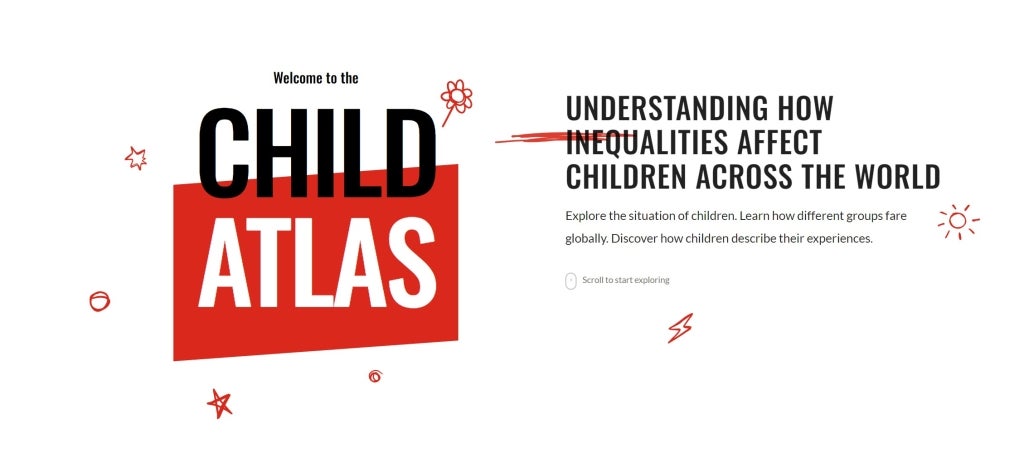This entry is a guest post by Oliver Fiala, Senior Research Adviser at Save the Children UK, a global child rights organization with more than 100 years of experience and 25,000 dedicated staff across 116 countries.

More children are surviving their early years than ever before – an astonishing accomplishment and testimony on what we can achieve together: Since 1990, the number of children dying before their fifth birthday worldwide has more than halved – from 12.5 million in 1990 to 5 million in 2021.
Many factors contributed to this progress, but childhood immunisation has played a crucial role, averting an estimated 4.4 million deaths every year. As seen in the chart below, UN data included in Save the Children’s new Child Atlas shows the opposite trends of the two indicators on a global level: the probability of a child dying before their fifth birthday decreased significantly as the proportion of children who received three doses of the diphtheria, pertussis and tetanus vaccine rose.
As remarkable this progress is globally, it hides significant inequalities and persistent challenges. For example, across low- and middle-income countries, a child born into the poorest 20% of households is twice as likely to die than one growing up in the richest households.
Zooming in, child mortality is now heavily concentrated in Sub-Saharan Africa and South Asia, home to more than 4 out of 5 child deaths; while Somalia, Nigeria, Chad, Guinea and the Central African Republic are some of the countries with the highest mortality and lowest vaccination rates. Furthermore, routine immunisations have declined recently, particularly during COVID-19 pandemic.
The previous example of under-five mortality and childhood vaccination also emphasizes the importance of understanding data in context, especially at a time when the world is increasingly facing multiple, overlapping crises. It is more important than ever to link indicators together to tell more insightful stories of progress, highlight countries where children face crises and insecurities, and describe potential policy solutions. Yet most of our data systems are designed to focus on one sector or indicator at a time, rather than analysing the linkages and overlaps. Save the Children’s Child Atlas seeks to fill this gap by providing an easy-to-use tool that brings together high-quality, publicly available data (spanning child-related outcomes, risks and insecurities, as well as public policies and funding decisions) and allows advocates, policymakers and children themselves to understand how different issues relate to each other.
Two further examples illustrate what insights and analyses the Child Atlas can provide. Let’s start by highlighting a few hotspots where children are at particularly high risk of both child marriage (measured as the proportion of women aged 20-24 who married before the age of 18) and extreme climate events (the proportion of the child population exposed to at least one extreme climate event per year). While this does not mean that climate risk necessarily increases child marriage (although there is evidence that it often does), the data helps us draw attention to countries where girls are growing up with a dual threat: increasingly frequent and severe climate disasters and the risk of being married as children (including as a response to the pressures that those crises put on families).
Examples include, for instance, Mozambique or Bangladesh, where 53% and 51% of girls get married before their 18th birthday. These countries are also highly exposed to climate change. Our data suggests that between 87% of children in Bangladesh – and 98% in Mozambique – are expected to experience at least one extreme climate event per year.
The overlap between different issues and indicators not only highlights threats to children's rights, but it should also spark conversations about solutions.
Let’s take, for example, access to maternal health care (illustrated by the proportion of women who received at least four antenatal care visits during their pregnancy) and public investment in health care. A quick glance at the data suggests that countries with higher health spending have more pregnant mothers accessing essential health services. This is the case in many high-income countries, but there are also many examples across middle-income economies, such as Costa Rica and Colombia. For example, in Costa Rica, 94% of pregnant mothers access antenatal care and public expenditure on health accounts to more than 25% of government spending, more than in any other country in our database.
Unfortunately, in countries like South Sudan or Yemen, only a minority of women access maternal health care (17% and 25%) and public investments in health are low (circa 2% of government spending goes towards health). Again, correlation is not causation as there may be other factors that explain this relationship. But this data provides a useful starting point for a conversation about the importance of investing in quality services for children and mothers.
In addition to the ability to overlap data, the Child Atlas includes disaggregated data where available, highlighting key child development indicators for different groups of children. We also integrated children's testimonies directly into the Atlas, allowing users to hear directly from children about their experiences, the problems they face and the changes they want adults to make. Our short video gives a quick overview of the different features.
With less than 7 years to go, the world is off track to meet many of the Sustainable Development Goals for children. We know that data is critical to understanding this situation: it helps us make better decisions, allocate resources more effectively, and hold policymakers accountable for their actions. The Child Atlas puts child-related data at your fingertips, allowing you to track progress on the SDGs and, importantly, to bring together data from different sectors and datasets to better understand the complex world in which we all operate.
Click here to access Save the Children’s Child Atlas.


Join the Conversation